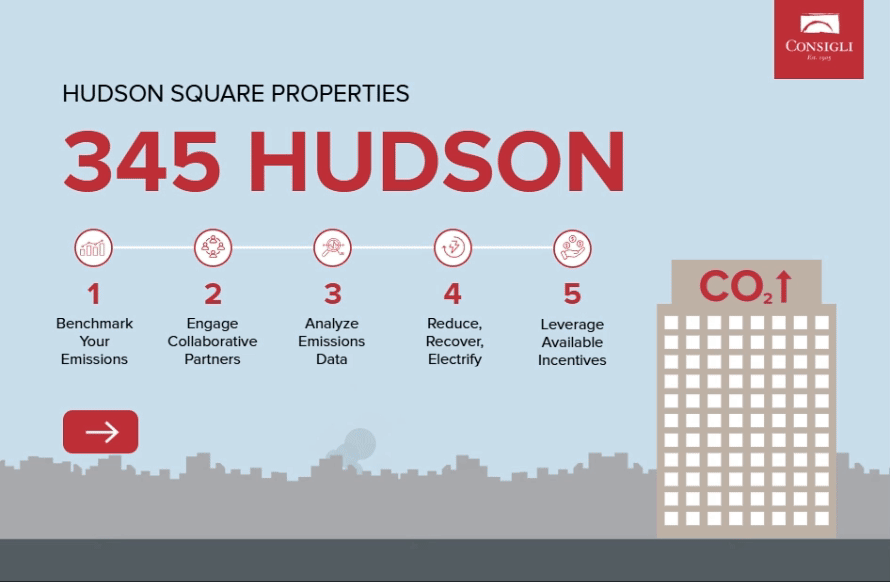Commercial buildings account for over 30% of all U.S. greenhouse gas emissions. With increasing local, regional and federal laws and disclosure requirements requiring reduced operational carbon emissions, businesses are compelled to prioritize decarbonization, or face penalization. Take New York City and Boston—two major cities issuing fines to commercial buildings for failing to comply with reducing carbon emissions:
New York City – Local Law 97: Local Law 97 mandates large buildings to significantly reduce their greenhouse gas emissions, aiming for a 40% reduction by 2030 and net-zero emissions by 2050. It is considered one of the most ambitious plans in the nation.
Boston – Building Emissions Reduction and Disclosure (BERDO): BERDO requires large buildings to report their annual energy and water use to the city by February 2025 and reduce their greenhouse gas emissions by 2023 in line with set targets, with the ultimate goal of reaching net-zero emissions by 2050.
By 2030, more than a dozen cities will follow suit, establishing their own regulations resembling New York City and Boston’s goals.
Planning for Successful Decarbonization
With 2030 approaching, the time for planning is now. Arch Energy, Consigli’s energy division, can help guide the planning of your decarbonization project starting with these key actions:
![]() Benchmark Your Emissions: Compare your building’s energy performance to similar buildings. Collect energy data on your building and calculate the emissions using the factors written in the law.
Benchmark Your Emissions: Compare your building’s energy performance to similar buildings. Collect energy data on your building and calculate the emissions using the factors written in the law.
![]() Engage Collaborative Partners: Ensure the success of your decarbonization projects by involving experienced partners from the beginning. The key to effectively decarbonizing older buildings lies in the early and active collaboration of all essential participants—architects, engineers, builders and clients.
Engage Collaborative Partners: Ensure the success of your decarbonization projects by involving experienced partners from the beginning. The key to effectively decarbonizing older buildings lies in the early and active collaboration of all essential participants—architects, engineers, builders and clients.
![]() Analyze Emissions Data: Identify areas where your building may be falling short of compliance and pinpoint emission hotspots. Collaborate with your design and construction team to evaluate the data and determine the most effective low-carbon projects or infrastructure upgrades for your property.
Analyze Emissions Data: Identify areas where your building may be falling short of compliance and pinpoint emission hotspots. Collaborate with your design and construction team to evaluate the data and determine the most effective low-carbon projects or infrastructure upgrades for your property.
![]() Reduce, Recover, Electrify: Identify waste heat not only to reduce your energy demand, but to see where heat can be reused to save 30% to 40% of carbon emissions. Once you reduce and recover available waste heat, begin to implement electrification measures.
Reduce, Recover, Electrify: Identify waste heat not only to reduce your energy demand, but to see where heat can be reused to save 30% to 40% of carbon emissions. Once you reduce and recover available waste heat, begin to implement electrification measures.
![]() Leverage Available Incentives: Understand the guardrails to qualified scope for incentives on planning and construction projects. Secure dollars by leveraging eligible tax credits and local utility and state incentives that enable zero carbon infrastructure.
Leverage Available Incentives: Understand the guardrails to qualified scope for incentives on planning and construction projects. Secure dollars by leveraging eligible tax credits and local utility and state incentives that enable zero carbon infrastructure.
Accelerating energy efficiency improvements can achieve more than a third of the total carbon dioxide (CO2) emission reductions needed between now and 2030, aligning with the goal of reaching net zero emissions by 2050.
The Advantage of Decarbonization
Adopting sustainable practices in building management offers advantages, both financially and reputationally. To transform your legacy building into a model for decarbonization, start today.
Economic: By adhering to sustainability standards, building owners can avoid potential fines and adapt more easily to new market conditions. Additionally, sustainable buildings typically have lower operating costs, longer lifespans and reduced environmental impact, which can translate into better financial performance over time.
Market Value: Decarbonization is a necessary step in reaching Net Zero goals and meeting stakeholder expectations, including those of tenants, investors and the community. Companies that prioritize sustainability not only enhance their reputation and brand value but also increase customer loyalty, attract new clients and provide a competitive edge in the market. By positioning a decarbonized legacy building as a premium, resilient asset, businesses improve their market standing.
Where We’re Doing It
345 Hudson, owned and currently being repositioned by Hudson Square Properties (HSP), is a model for sustainable practices, incorporating Nordic design principles of holistic energy recycling and electrification and serving as a scalable solution for Local Law 97 compliance. Because of its natural gas operations, mid-tier energy rating and carbon emissions, the 990,000 sq. ft. 345 Hudson was destined to face recurring Local Law 97 carbon emissions fines starting in 2035. Over a seven-year period, 345 Hudson is undergoing infrastructure changes that will make its decarbonization a reality.
Learn more about the project here.

